garage chemist
chemical wizard
    
Posts: 1803
Registered: 16-8-2004
Location: Germany
Member Is Offline
Mood: No Mood
|
|
The glassy carbon Anode: First test in a chlorate cell
Glassy carbon is a unique form of pure carbon with outstanding properties that set it apart from graphite.
While graphite is grey, soft and rubs off easily, glassy carbon is shiny, black, hard and does not leave a line when rubbed on paper.
It is also extremely chemically resistant (no acid, base, or oxidising melt attacks it) and oxidises about ten times slower than graphite in air at
high temperature.
It is used for making crucibles for high-end analytical equipment and for melting noble and reactive metals. Glassy carbon has remarkable nonwetting
properties- molten metals, salts and even glasses do not wet it.
Glassy carbon crucibles find use in dentistry for melting precious metal alloys without any fluxes.
The idea of using glassy carbon as an inert anode has been brought up before: http://www.sciencemadness.org/talk/viewthread.php?tid=4411#p...
but I haven't heard or read of anyone trying it in a chlorate cell, so I assembled a test cell using a glassy carbon melting crucible.
This is the glassy carbon crucible I'm using, 10cm long and 2,4cm outside diameter, trade name SIGRADUR.
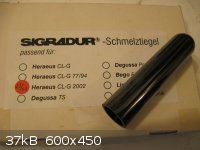
This is how it's attached to the cell lid using a piece of PP pipe and hotmelt glue. The cathodes are strips of 1mm titanium sheet, 2cm wide, and
sealed to the lid using RTV silicone caulk. Also note the offgas pipe.
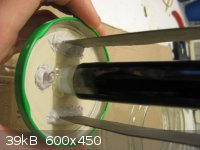
The anode is pressed against the cell lid by a bent piece of Ti sheet. This is meant to prevent the anode falling off when the hotmelt glue is
softening or being attacked.
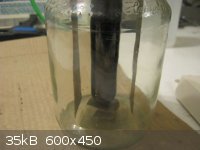
The electrical connections. The anode is contacted by a thin strip of titanium running down it.
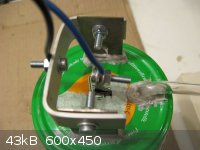
The setup- the offgas passes through a washing bottle with 10% NaOH to absorb the chlorine and prevent it from stinking up the house (I'm running the
cell in my living room).
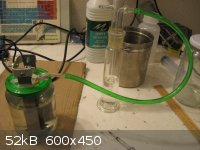
The cell, filled with 500ml of saturated NaCl solution (no additives, no pH control) and started at 500mA.
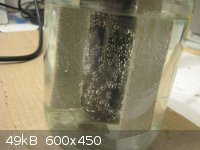
The cell running at 4A. It clouded up rapidly from the hydrogen bubbles after this picture was taken.
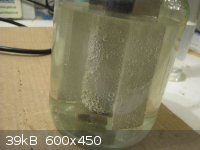
The cathodes are running at 62 mA/cm2, with unprotected backside. The anode is running at about the same current density.
Shortly after turning on, the headspace above the solution was colored green from the evolving chlorine. After about 20 minutes had passed, the color
had disappeared, and now, after 1 hour, practically no more chlorine is being evolved, as evidenced by lack of smell when the plastic hose to the
washing bottle is disconnected.
Instead, the offgas from the washing bottle has started to smell of ozone (!). This is reminiscent of my platinum anode perchlorate cell, which also
produces ozone. Perhaps glassy carbon might even make perchlorate- but for now, I'm trying to find out how it holds up in a sodium chlorate cell
without pH control and high anodic current density.
Since there is no pH control, 9 electrons will be needed to make 1 mole of chlorate, and I'm going to let it run for the time that is theoretically
needed to bring the NaCl content down to 100g/L.
[Edited on 23-1-2011 by garage chemist]
|
|
|
dann2
International Hazard
    
Posts: 1523
Registered: 31-1-2007
Member Is Offline
Mood: No Mood
|
|
Hello,
Nice one GarageChemist!
Just wondering how much the crucible cost?
Dann2
|
|
|
garage chemist
chemical wizard
    
Posts: 1803
Registered: 16-8-2004
Location: Germany
Member Is Offline
Mood: No Mood
|
|
I don't remember, it was a bargain on ebay, at much less than the actual cost.
When ordered from the catalogue the cost is around EUR 100 for five crucibles.
I've googled a bit for other suppliers than the german HTW GmbH, which manufactures glassy carbon crucibles, rods, tubes, sheets etc. under the
Sigradur brand and they are all much more expensive.
Look here, for example: http://www.2spi.com/catalog/mounts/glassy-carbon-test-tubes....
This is the german manufacturer: http://www.htw-gmbh.de/products.php5?lang=en&nav0=3
|
|
|
garage chemist
chemical wizard
    
Posts: 1803
Registered: 16-8-2004
Location: Germany
Member Is Offline
Mood: No Mood
|
|
After running for 17 hours, no more chlorine is being evolved, as the pH has now most likely stabilized at a high value.
The cell has shown some weird behavior yesterday.
The voltage was at 5,2V, and I switched off the power for a few minutes to look at the anode, and after switching it on again it suddenly was only 4V,
and has not increased again since.
I'm testing the cell offgas for its oxygen content by immersing the washing bottle inlet tube in a beaker filled with water and a little dishwashing
detergent. This makes bubbles on the surface, and after removing the inlet tube, I ignite them with a lighter.
A few hours after startup, the bubbles ignited with a soft "pop" indicating almost pure hydrogen offgas.
Now, the bubbles go "bang", showing significant oxygen evolution at the anode due to the high pH. But it's absolutely not the sharp, deafening
"BANG!!!" that a stochiometric H2/O2 mixture would make and that I would instantly recognize.
An Eudiometer would be very handy to have now, as this would allow a volumetric determination of the oxygen content by combusting it with hydrogen and
measuring the volume reduction.
What's very encouraging is the fact that there's absolutely no black sludge in the cell. The cell liquor is clear!
[Edited on 24-1-2011 by garage chemist]
|
|
|
hissingnoise
International Hazard
    
Posts: 3940
Registered: 26-12-2002
Member Is Offline
Mood: Pulverulescent!
|
|
That's very interesting gc; if it will go to perchlorate with any efficiency the anode will well justify its higher cost!
Bated breath, and all that . . .
|
|
|
garage chemist
chemical wizard
    
Posts: 1803
Registered: 16-8-2004
Location: Germany
Member Is Offline
Mood: No Mood
|
|
Picture of the cell after 50 hours; 200Ah have flown.
The liquid level has sunk by about 1cm, it was topped up with 50ml saturated NaCl solution.
The cell has been standing in a water bath for cooling, this keeps its temperature below 50°C.
There is no black sludge at all. I think this picture makes it clear to anyone who has ever run a graphite anode chlorate cell with no pH control and
high anodic current density that glassy carbon does not shred like graphite and holds up much better in alkaline solution.
The surface of the anode is still glassy, but there are many dull spots where tiny shards have separated from the surface. These black shards can be
seen at the bottom of the cell.
[Edited on 25-1-2011 by garage chemist]
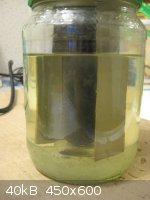
|
|
|
garage chemist
chemical wizard
    
Posts: 1803
Registered: 16-8-2004
Location: Germany
Member Is Offline
Mood: No Mood
|
|
Results after the cell has run for 88h and 350Ah have passed through it:
The anode has suffered visible erosion, but it looks nothing like graphite. The surface is still glassy, but there are many shallow holes where pieces
have spalled off. Diameter reduction of the anode is very small, only 0,1mm at most, and the anode would most likely survive tens of additional runs
if erosion continues at this rate.
I haven't analyzed the cell liquor yet- I have to decide on a method first. I was thinking of boiling down a neutralized sample, drying the residue at
150°C in an oven, weighing out 10g with an accuracy of 0,01g and heating it to total decomposition to measure weight loss. From this, a chlorate
content of the dry salt can be calculated.
The only problem I see with this is the fact that heating chlorate to release oxygen always forms some perchlorate, which needs a temperature of at
least 550°C to decompose, dangerously close to the softening point of borosilicate glass.
I don't want to heat it in a crucible due to the potential for loss of material through spattering.
Any ideas for a good method to determine chlorate in cell liquor? I don't want to use iodometric titration since this would require lengthy and
laborious preparation and standardization of sodium thiosulfate solution- I would have to make and purify potassium iodate for use as a reference
substance first.
See the picture for a close up of the used anode.
I think that glassy carbon is an interesting anode material which corrodes much less than graphite and does not turn the cell liquor black.
However, it is not the totally inert platinum equivalent anode that I had hoped it to be.
Whether it makes sense to use it in a chlorate cell depends on the price that it can be obtained for. It certainly has its advantages over graphite.
Experimentation concerning possible perchlorate formation on glassy carbon anode will be done when I have time.
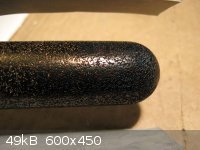
[Edited on 1-2-2011 by garage chemist]
|
|
|
Twospoons
International Hazard
    
Posts: 1322
Registered: 26-7-2004
Location: Middle Earth
Member Is Offline
Mood: A trace of hope...
|
|
All we need now is a method to make glassy carbon! From what I've seen around the web, it is basically phenolic resin pyrolyzed in a reducing
atmosphere at 1600 - 2000 C.
Helicopter: "helico" -> spiral, "pter" -> with wings
|
|
|
garage chemist
chemical wizard
    
Posts: 1803
Registered: 16-8-2004
Location: Germany
Member Is Offline
Mood: No Mood
|
|
From what I've read, only 1000°C are needed for the pyrolysis, easily reachable with any Nichrome heated electric oven.
The catch is the heating rate. Since the gases can only escape very slowly from the nonporous material and the shrinkage is very large, the pyrolysis
process extends over weeks, with a heating rate of 1-5K per hour. The maximum wall thickness of glassy carbon artifacts is also limited to 5mm, due to
this problem of gas release.
The reducing atmosphere can be attained by simply burying the precursor moldings in powdered coke in a covered crucible- no need for an inert gas
filled oven.
High-grade glassy carbon is then subjected to a high-temperature treatment at 2700°C in an Acheson (graphitization) furnace, the furnace in which
carbonized pitch-bound petrol coke artifacts are normally turned into high-quality graphite.
Less expensive glassy carbon (and cheap "graphite" such as gouging rods or battery carbon rods, which aren't actual graphite) artifacts don't get this
treatment. I don't know whether my dental melting crucibles are treated this way or not.
|
|
|
Sedit
International Hazard
    
Posts: 1939
Registered: 23-11-2008
Member Is Offline
Mood: Manic Expressive
|
|
I have looked in the past for a means of glassy carbon production but personally it always seemed a better option to buy it other then make it. Thanks
for the test results G_C, I was curious about these electrods since they also show very good production of Kolbe products in the Kolbe electrolysis on
par with the use of Platinum anodes. I would assume these would be cheeper then the Pt anodes.
Knowledge is useless to useless people...
"I see a lot of patterns in our behavior as a nation that parallel a lot of other historical processes. The fall of Rome, the fall of Germany — the
fall of the ruling country, the people who think they can do whatever they want without anybody else's consent. I've seen this story
before."~Maynard James Keenan
|
|
|
Twospoons
International Hazard
    
Posts: 1322
Registered: 26-7-2004
Location: Middle Earth
Member Is Offline
Mood: A trace of hope...
|
|
So we really need a phenolic foam as a staring material. This has two advantages: easy gas release in pyrolysis and greater surface area for electrode
use.
Helicopter: "helico" -> spiral, "pter" -> with wings
|
|
|
Formatik
National Hazard
   
Posts: 927
Registered: 25-3-2008
Member Is Offline
Mood: equilibrium
|
|
Quote: Originally posted by garage chemist  | | Any ideas for a good method to determine chlorate in cell liquor? I don't want to use iodometric titration since this would require lengthy and
laborious preparation and standardization of sodium thiosulfate solution- I would have to make and purify potassium iodate for use as a reference
substance first. |
Maybe another way useful could be through AgNO3. Silver chlorate is relatively soluble, so to estimate how much chloride there is relative to chlorate
should be easy to figure out. And practically all silver can be recovered as the chloride. I've also got several pages of chlorate determination from
Gmelin I could scan.
|
|
|
froot
Hazard to Others
  
Posts: 347
Registered: 23-10-2003
Location: South Africa
Member Is Offline
Mood: refluxed
|
|
This sounds similar to the production of graphene and may be a rudimentary version of it.
Apparently it can be made with sucrose!
http://inhabitat.com/graphene-the-new-building-material-made...
http://en.wikipedia.org/wiki/Graphene
We salute the improvement of the human genome by honoring those who remove themselves from it.
Of necessity, this honor is generally bestowed posthumously. - www.darwinawards.com |
|
|
tnphysics
Harmless

Posts: 18
Registered: 29-12-2010
Member Is Offline
Mood: No Mood
|
|
Quote: Originally posted by garage chemist  | Glassy carbon is a unique form of pure carbon with outstanding properties that set it apart from graphite.
While graphite is grey, soft and rubs off easily, glassy carbon is shiny, black, hard and does not leave a line when rubbed on paper.
It is also extremely chemically resistant (no acid, base, or oxidising melt attacks it) and oxidises about ten times slower than graphite in air at
high temperature.
It is used for making crucibles for high-end analytical equipment and for melting noble and reactive metals. Glassy carbon has remarkable nonwetting
properties- molten metals, salts and even glasses do not wet it.
Glassy carbon crucibles find use in dentistry for melting precious metal alloys without any fluxes.
The idea of using glassy carbon as an inert anode has been brought up before: http://www.sciencemadness.org/talk/viewthread.php?tid=4411#p...
but I haven't heard or read of anyone trying it in a chlorate cell, so I assembled a test cell using a glassy carbon melting crucible.
This is the glassy carbon crucible I'm using, 10cm long and 2,4cm outside diameter, trade name SIGRADUR.
This is how it's attached to the cell lid using a piece of PP pipe and hotmelt glue. The cathodes are strips of 1mm titanium sheet, 2cm wide, and
sealed to the lid using RTV silicone caulk. Also note the offgas pipe.
The anode is pressed against the cell lid by a bent piece of Ti sheet. This is meant to prevent the anode falling off when the hotmelt glue is
softening or being attacked.
The electrical connections. The anode is contacted by a thin strip of titanium running down it.
The setup- the offgas passes through a washing bottle with 10% NaOH to absorb the chlorine and prevent it from stinking up the house (I'm running the
cell in my living room).
The cell, filled with 500ml of saturated NaCl solution (no additives, no pH control) and started at 500mA.
The cell running at 4A. It clouded up rapidly from the hydrogen bubbles after this picture was taken.
The cathodes are running at 62 mA/cm2, with unprotected backside. The anode is running at about the same current density.
Shortly after turning on, the headspace above the solution was colored green from the evolving chlorine. After about 20 minutes had passed, the color
had disappeared, and now, after 1 hour, practically no more chlorine is being evolved, as evidenced by lack of smell when the plastic hose to the
washing bottle is disconnected.
Instead, the offgas from the washing bottle has started to smell of ozone (!). This is reminiscent of my platinum anode perchlorate cell, which also
produces ozone. Perhaps glassy carbon might even make perchlorate- but for now, I'm trying to find out how it holds up in a sodium chlorate cell
without pH control and high anodic current density.
Since there is no pH control, 9 electrons will be needed to make 1 mole of chlorate, and I'm going to let it run for the time that is theoretically
needed to bring the NaCl content down to 100g/L.
[Edited on 23-1-2011 by garage chemist] |
Why are 9 electrons needed per mole of chlorate in the absence of ph control?
I LOVE science!
|
|
|
dann2
International Hazard
    
Posts: 1523
Registered: 31-1-2007
Member Is Offline
Mood: No Mood
|
|
Simple Titrations
Hello,
If there are little or no black deposits in the cell then perhaps most of the Graphite is going away as CO2 as opposed to a physical shredding
process. This happens in ordinary Graphite Anode Chlorate cells.
There are simple enough titrations for Chlorate and Chloride here:
http://www.oxidizing.110mb.com/chlorate/tests.html
There is a more exaction titration for Chlorate here:
http://www.oxidizing.110mb.com/chlorate/akagraph.html
@tnphysics
See here for some info. on reactions in Chlorate cells.
http://www.oxidizing.110mb.com/chlorate/reaction.html
Dann2
|
|
|
tnphysics
Harmless

Posts: 18
Registered: 29-12-2010
Member Is Offline
Mood: No Mood
|
|
What prevents the reaction ClO- + 4OH- -> ClO3- + 2H2O + 4e-?
This seems to be more likely with a non-catalytic anode.
[Edited on 2-2-2011 by tnphysics]
I LOVE science!
|
|
|
dann2
International Hazard
    
Posts: 1523
Registered: 31-1-2007
Member Is Offline
Mood: No Mood
|
|
Quote: Originally posted by garage chemist  |
.....................
Experimentation concerning possible perchlorate formation on glassy carbon anode will be done when I have time.
[Edited on 1-2-2011 by garage chemist] |
Hello,
I guess you never got around to doing this yet Garage Chemist?
Dann2
|
|
|
PHILOU Zrealone
International Hazard
    
Posts: 2893
Registered: 20-5-2002
Location: Brussel
Member Is Offline
Mood: Bis-diazo-dinitro-hydroquinonic
|
|
Addition of some MnO2 or KMnO4 to your chlorate might help reduce the temperature to set all oxygen free.
This procedure was used in old times labo to produce pure oxygen from dry chlorate with moderate heating. 
PH Z (PHILOU Zrealone)
"Physic is all what never works; Chemistry is all what stinks and explodes!"-"Life that deadly disease, sexually transmitted."(W.Allen)
|
|
|